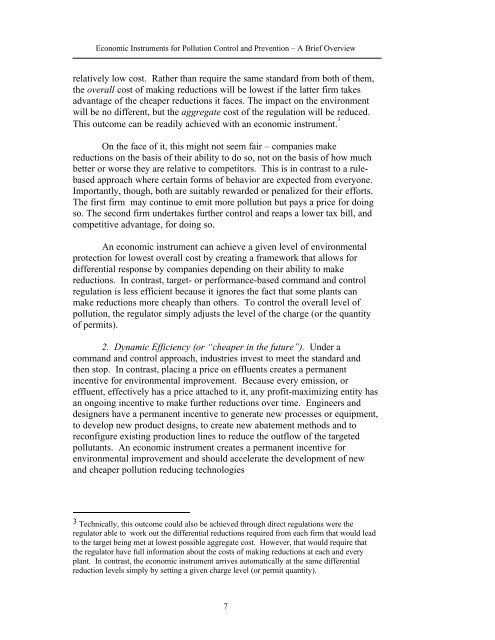Economic Instruments for Pollution Control and Prevention - World ...
Economic Instruments for Pollution Control and Prevention - World ...
Economic Instruments for Pollution Control and Prevention - World ...
You also want an ePaper? Increase the reach of your titles
YUMPU automatically turns print PDFs into web optimized ePapers that Google loves.
<strong>Economic</strong> <strong>Instruments</strong> <strong>for</strong> <strong>Pollution</strong> <strong>Control</strong> <strong>and</strong> <strong>Prevention</strong> – A Brief Overview<br />
relatively low cost. Rather than require the same st<strong>and</strong>ard from both of them,<br />
the overall cost of making reductions will be lowest if the latter firm takes<br />
advantage of the cheaper reductions it faces. The impact on the environment<br />
will be no different, but the aggregate cost of the regulation will be reduced.<br />
This outcome can be readily achieved with an economic instrument. 3<br />
On the face of it, this might not seem fair – companies make<br />
reductions on the basis of their ability to do so, not on the basis of how much<br />
better or worse they are relative to competitors. This is in contrast to a rulebased<br />
approach where certain <strong>for</strong>ms of behavior are expected from everyone.<br />
Importantly, though, both are suitably rewarded or penalized <strong>for</strong> their ef<strong>for</strong>ts.<br />
The first firm may continue to emit more pollution but pays a price <strong>for</strong> doing<br />
so. The second firm undertakes further control <strong>and</strong> reaps a lower tax bill, <strong>and</strong><br />
competitive advantage, <strong>for</strong> doing so.<br />
An economic instrument can achieve a given level of environmental<br />
protection <strong>for</strong> lowest overall cost by creating a framework that allows <strong>for</strong><br />
differential response by companies depending on their ability to make<br />
reductions. In contrast, target- or per<strong>for</strong>mance-based comm<strong>and</strong> <strong>and</strong> control<br />
regulation is less efficient because it ignores the fact that some plants can<br />
make reductions more cheaply than others. To control the overall level of<br />
pollution, the regulator simply adjusts the level of the charge (or the quantity<br />
of permits).<br />
2. Dynamic Efficiency (or “cheaper in the future”). Under a<br />
comm<strong>and</strong> <strong>and</strong> control approach, industries invest to meet the st<strong>and</strong>ard <strong>and</strong><br />
then stop. In contrast, placing a price on effluents creates a permanent<br />
incentive <strong>for</strong> environmental improvement. Because every emission, or<br />
effluent, effectively has a price attached to it, any profit-maximizing entity has<br />
an ongoing incentive to make further reductions over time. Engineers <strong>and</strong><br />
designers have a permanent incentive to generate new processes or equipment,<br />
to develop new product designs, to create new abatement methods <strong>and</strong> to<br />
reconfigure existing production lines to reduce the outflow of the targeted<br />
pollutants. An economic instrument creates a permanent incentive <strong>for</strong><br />
environmental improvement <strong>and</strong> should accelerate the development of new<br />
<strong>and</strong> cheaper pollution reducing technologies<br />
3 Technically, this outcome could also be achieved through direct regulations were the<br />
regulator able to work out the differential reductions required from each firm that would lead<br />
to the target being met at lowest possible aggregate cost. However, that would require that<br />
the regulator have full in<strong>for</strong>mation about the costs of making reductions at each <strong>and</strong> every<br />
plant. In contrast, the economic instrument arrives automatically at the same differential<br />
reduction levels simply by setting a given charge level (or permit quantity).<br />
7

















